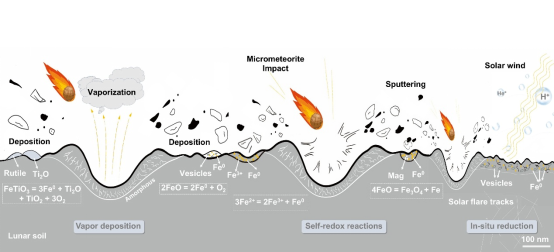Lunar surface weathering processes are pivotal for understanding the evolution of airless planetary bodies. Traditional theories, based on laboratory analyses and remote-sensing data, suggest that lunar space weathering is primarily driven by reduction processes induced by micrometeorite impacts and solar wind irradiation. These processes typically result in the formation of nanophase metallic iron (np-Fe0) and spectral reddening. However, recent analyses of Chang'e-5/6 samples and remote-sensing observations have revealed the coexistence of impact-generated magnetite, disproportionation reactions, and oxidation signatures potentially induced by Earth's magnetotail. These conflicting evolutionary signals indicate that existing models struggle to fully characterize the oxidation-reduction pathways in lunar weathering.
To address this challenge, a joint team from the Institute of Geochemistry (Chinese Academy of Sciences), Sun Yat-sen University, Yunnan University, and Guilin University of Technology, employ multi-scale analytical techniques—including transmission electron microscopy(TEM), electron energy loss spectroscopy(EELS), and electron spin resonance (ESR)—to systematically analyze regolith samples from Chang'e-5 (near side) and Chang'e-6 (far side).
The team constructs a multi-scale dynamic framework encompassing "vapor deposition-driven open reductive reactions," "in situ reduction reactions," and "self-redox reactions." For example, vapor-deposited layers observed on pyroxene grains from Chang'e-6 contain np-Fe⁰ particles and vesicular structures, providing direct evidence of high-temperature vapor condensation caused by micrometeorite impacts. Meanwhile, iron whiskers and porous textures in Chang'e-5 sulfide grains reveal sulfur loss and in situ reduction under the synergistic effect of impact events and solar wind irradiation.
This research expands the understanding of lunar redox processes from a single mechanism to a dynamically multi-driven system, revising the simplified "purely reducing environment" paradigm from the Apollo era. The new framework not only provides a theoretical basis for interpreting lunar spectral evolution and mineral assemblage changes but also establishes a universal paradigm for space weathering studies of airless bodies like Mercury and asteroids. For instance, Mercury's higher iron content and unique spectral features may interrelate with its more intense impact vapor deposition processes.
Comparisons between the far-side Chang'e-6 samples (from the South Pole-Aitken Basin, ~2.8 Ga) and near-side Chang'e-5 samples (Is/FeO = 66 ± 3.2 vs. 65 ± 10) offer critical data for unraveling the spatiotemporal heterogeneity of lunar surface evolution. Integrating future sample return missions and in situ detection technologies, this framework will further refine cross-scale theories of extraterrestrial weathering, providing scientific support for lunar resource utilization and deep space exploration.

Schematic diagram of redox dynamics at multiple scales on the lunar surface, including vapor deposition-driven open reductive reactions, in-situ reduction reactions, and self-redox reactions.(Image by IGCAS)
Contact:
LI Yang
Institute of Geochemistry, Chinese Academy of Sciences
Email: liyang@mail.gyig.ac.cn
(By Prof. LI Yang’s group)